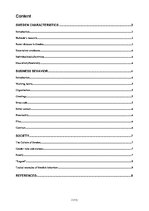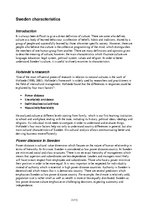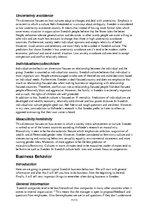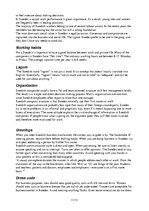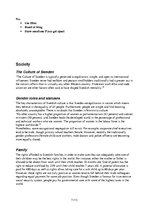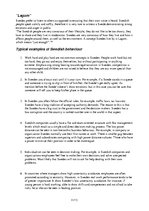-
Sweden Cultural Characteristics
Bezmaksas!
| Nr. | Sadaļas nosaukums | Lpp. |
| Sweden characteristics | 3 | |
| Introduction | 3 | |
| Hofstede’s research | 3 | |
| Power distance in Sweden | 3 | |
| Uncertainty avoidance | 4 | |
| Individualism/collectivism | 4 | |
| Masculinity/femininity | 4 | |
| Business Behavior | 4 | |
| Introduction | 4 | |
| Working habits | 5 | |
| Organization | 5 | |
| Greetings | 5 | |
| Dress code | 5 | |
| Initial contact | 6 | |
| Punctuality | 6 | |
| Fika | 6 | |
| Contract | 6 | |
| Society | 7 | |
| The Culture of Sweden | 7 | |
| Gender roles and statuses | 7 | |
| Family | 7 | |
| “Lagom” | 8 | |
| Typical examples of Swedish behaviour | 8 | |
| References | 9 |
Sweden characteristics
Introduction
It is always been difficult to give a direct definition of culture. There are some who defines culture as a body of learned behaviour, a collection of beliefs, habits and traditions, shared by a group of people and successfully learned by those who enter specific society. However, there are people who believe that culture is the collective programming of the mind, which distinguishes the members of one human group from another. There are many definitions and opinions given to describe meaning of culture; however, the main characteristics which illustrate culture are language, education, legal system, political system, values and religion. In order to better understand Sweden’s culture, it is useful to closely examine its characteristics.
Hofstede’s research
‘One of the most influential pieces of research in relation to national cultures is the work of Hofstede (1980; 2001). Hofstede’s framework is widely used by researchers and practitioners in the field of intercultural management. Hofstede found that the differences in responses could be explained by four main factors’i:
Power distance
Uncertainty avoidance
Individualism/collectivism
Masculinity/femininity
He analyzed culture at different levels starting from family, which is our first learning institution, to school and workplace, ending with the state, including its history, political ideas, ideology and religions. As individual mind needs to compare in order to understand and evaluate things, Hofstede’s four main factors help not only to understand country differences in general, but also main cultural characteristics of Sweden. His cultural analysis allows communicating better and deriving business more efficiently. …
Darbs rakstīts Cross Cultural Management mācību kursā. Darbs par Zviedriju angļu valodā(tēmas kuras tiek apraktitas: Zviedrijas kultūras īpatnības/kā veidot biznesa attiecības Zviedrijā/sabiedrība)[Sweden - Cultural Characteristics/Business Behavior/Society] Content: SWEDEN CHARACTERISTICS Introduction Hofstede’s research Power distance in Sweden Uncertainty avoidance Individualism/collectivism Masculinity/femininity BUSINESS BEHAVIOR Introduction General information Working habits Lagom Organization Greetings Dress code Initial contact Punctuality Meeting Fika Managers roll Contract Yes and No, in Business Bahavior SOCIETY The Culture of Sweden Gender roles and statuses Family “Lagom” Typical examples of Swedish behavior References


